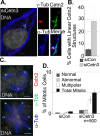Centrin 3 is an inhibitor of centrosomal Mps1 and antagonizes centrin 2 function
- PMID: 26354417
- PMCID: PMC4626060
- DOI: 10.1091/mbc.E14-07-1248
Centrin 3 is an inhibitor of centrosomal Mps1 and antagonizes centrin 2 function
Abstract
Centrins are a family of small, calcium-binding proteins with diverse cellular functions that play an important role in centrosome biology. We previously identified centrin 2 and centrin 3 (Cetn2 and Cetn3) as substrates of the protein kinase Mps1. However, although Mps1 phosphorylation sites control the function of Cetn2 in centriole assembly and promote centriole overproduction, Cetn2 and Cetn3 are not functionally interchangeable, and we show here that Cetn3 is both a biochemical inhibitor of Mps1 catalytic activity and a biological inhibitor of centrosome duplication. In vitro, Cetn3 inhibits Mps1 autophosphorylation at Thr-676, a known site of T-loop autoactivation, and interferes with Mps1-dependent phosphorylation of Cetn2. The cellular overexpression of Cetn3 attenuates the incorporation of Cetn2 into centrioles and centrosome reduplication, whereas depletion of Cetn3 generates extra centrioles. Finally, overexpression of Cetn3 reduces Mps1 Thr-676 phosphorylation at centrosomes, and mimicking Mps1-dependent phosphorylation of Cetn2 bypasses the inhibitory effect of Cetn3, suggesting that the biological effects of Cetn3 are due to the inhibition of Mps1 function at centrosomes.
© 2015 Sawant et al. This article is distributed by The American Society for Cell Biology under license from the author(s). Two months after publication it is available to the public under an Attribution–Noncommercial–Share Alike 3.0 Unported Creative Commons License (http://creativecommons.org/licenses/by-nc-sa/3.0).
Figures










Similar articles
-
Mps1 phosphorylation sites regulate the function of centrin 2 in centriole assembly.Mol Biol Cell. 2010 Dec;21(24):4361-72. doi: 10.1091/mbc.E10-04-0298. Epub 2010 Oct 27. Mol Biol Cell. 2010. PMID: 20980622 Free PMC article.
-
CDC25B overexpression stabilises centrin 2 and promotes the formation of excess centriolar foci.PLoS One. 2013 Jul 1;8(7):e67822. doi: 10.1371/journal.pone.0067822. Print 2013. PLoS One. 2013. PMID: 23840880 Free PMC article.
-
Preventing the degradation of mps1 at centrosomes is sufficient to cause centrosome reduplication in human cells.Mol Biol Cell. 2007 Nov;18(11):4457-69. doi: 10.1091/mbc.e07-03-0283. Epub 2007 Sep 5. Mol Biol Cell. 2007. PMID: 17804818 Free PMC article.
-
A mechanistic view on the evolutionary origin for centrin-based control of centriole duplication.J Cell Physiol. 2007 Nov;213(2):420-8. doi: 10.1002/jcp.21226. J Cell Physiol. 2007. PMID: 17694534 Review.
-
Such small hands: the roles of centrins/caltractins in the centriole and in genome maintenance.Cell Mol Life Sci. 2012 Sep;69(18):2979-97. doi: 10.1007/s00018-012-0961-1. Epub 2012 Mar 30. Cell Mol Life Sci. 2012. PMID: 22460578 Free PMC article. Review.
Cited by
-
Duplication and Nuclear Envelope Insertion of the Yeast Microtubule Organizing Centre, the Spindle Pole Body.Cells. 2018 May 10;7(5):42. doi: 10.3390/cells7050042. Cells. 2018. PMID: 29748517 Free PMC article. Review.
-
Tetrahymena Poc5 is a transient basal body component that is important for basal body maturation.J Cell Sci. 2020 Jun 4;133(11):jcs240838. doi: 10.1242/jcs.240838. J Cell Sci. 2020. PMID: 32350068 Free PMC article.
-
Insights into photoreceptor ciliogenesis revealed by animal models.Prog Retin Eye Res. 2019 Jul;71:26-56. doi: 10.1016/j.preteyeres.2018.12.004. Epub 2018 Dec 25. Prog Retin Eye Res. 2019. PMID: 30590118 Free PMC article. Review.
-
Malaria parasite centrins can assemble by Ca2+-inducible condensation.PLoS Pathog. 2023 Dec 27;19(12):e1011899. doi: 10.1371/journal.ppat.1011899. eCollection 2023 Dec. PLoS Pathog. 2023. PMID: 38150475 Free PMC article.
-
Piezo mechanosensory channels regulate centrosome integrity and mitotic entry.Proc Natl Acad Sci U S A. 2023 Jan 3;120(1):e2213846120. doi: 10.1073/pnas.2213846120. Epub 2022 Dec 27. Proc Natl Acad Sci U S A. 2023. PMID: 36574677 Free PMC article.
References
-
- Araki M, Masutani C, Takemura M, Uchida A, Sugasawa K, Kondoh J, Ohkuma Y, Hanaoka F. Centrosome protein centrin 2/caltractin 1 is part of the xeroderma pigmentosum group C complex that initiates global genome nucleotide excision repair. J Biol Chem. 2001;276:18665–18672. - PubMed
-
- Baron AT, Greenwood TM, Bazinet CW, Salisbury JL. Centrin is a component of the pericentriolar lattice. Biol Cell. 1992;76:383–388. - PubMed
Publication types
MeSH terms
Substances
Grants and funding
LinkOut - more resources
Full Text Sources
Molecular Biology Databases

